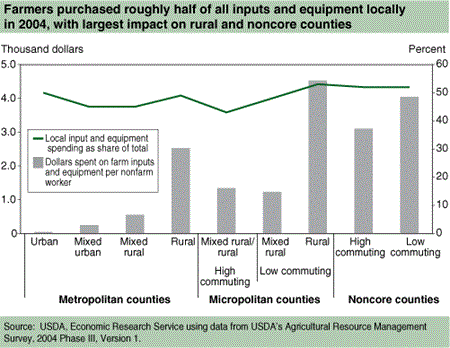Half of Farm Expenditures Are Spent Locally

Total farm business operating expenditures amounted to more than $187 billion in 2008. A recent ERS-supported study found that about half of all farm input and equipment expenditures were made locally in 2004. Researchers examined the purchasing patterns of farmers to determine the likely impact of farm spending on various types of local economies, from highly urban to totally rural. In the 2004 Agricultural Resource Management Survey, a joint effort by ERS and USDA’s National Agricultural Statistics Service, farmers were asked how far they travel to purchase most of their farm inputs and equipment.
Farmers were also asked the distance to the nearest town (the average was 8.3 miles) and nearest city of more than 10,000 people (the average was 24.2 miles). If a farmer traveled farther than the nearest city of 10,000, farm-related purchases were considered “nonlocal.” To determine if the local share of farm purchases varied by location, and to better gauge the potential impact of these expenditures on nearby communities, counties with farms were categorized according to their proximity to urban centers, population density, and commuting patterns. The assumption was that farming is not likely to have a large impact on the economies of more urban, densely settled communities or on nonmetropolitan areas that are highly dependent on metro economies (based on their commuting patterns).
The study found that farm business expenditures were potentially much more important in rural counties (those with low-density, non-urban settlement) than in urban counties in 2004, whether metro or nonmetro. Farm expenditures per nonfarm worker in a county, a measure of the relative importance of farming to a local economy, averaged about $4,500 in rural micropolitan counties (defined as counties containing an urban core with a population between 10,000 and 50,000)—more than 100 times the $41 urban metropolitan county average.
Furthermore, in the least urban counties, the relative importance of the farm sector was reduced where a significant share of residents commute to jobs outside of the county. Despite large differences in the relative importance of farming across county types, roughly half of all farm purchases were made locally.
Farm Business and Household Expenditure Patterns and Local Communities: Evidence from a National Farm Survey, Review of Agricultural Economics, September 2009, Vol. 31, No. 3, pp. 604-626.


